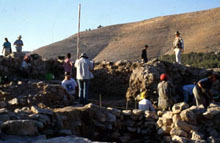 At Khirbat Iskandar our staff over the years has included: a director, associate or co-directors, ceramist, a camp manager, a registrar, an artist, an otographer, a surveyor/architect, a palaeoethnobotanist, a palaeoethnozoologist, an osteologist, a geolomorphologist and a computer or information specialist. There are many different types of specialists depending on the needs of the dig. For example, Khirbat Iskandar has no specialist in mosaics since there are no Roman or Byzantine remains at the site.
At Khirbat Iskandar our staff over the years has included: a director, associate or co-directors, ceramist, a camp manager, a registrar, an artist, an otographer, a surveyor/architect, a palaeoethnobotanist, a palaeoethnozoologist, an osteologist, a geolomorphologist and a computer or information specialist. There are many different types of specialists depending on the needs of the dig. For example, Khirbat Iskandar has no specialist in mosaics since there are no Roman or Byzantine remains at the site. 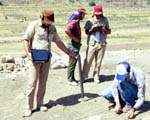
Sometimes specialists are brought in on occasion. We had an expert in remote sensing at Khirbat Iskandar in 1984. This person used a magnetometer to help us find cemeteries. Generally remote sensing devices can detect remains below the ground and thus help the archaeologist decide where to dig. Archaeologists are now even being helped by NASA's radar and infrared devices.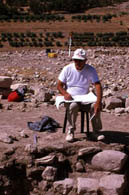
Field Staff
There are usually layers of supervisory staff. Below the directors are field supervisors who control a number of squares in a field. Each square then has it own supervisor and possibly an assistant. Volunteers work in the squares. In the Near East a number of local laborers are usually hired to work as well.
In many ways the square supervisor is the most important of all. He or she is responsible for recording everything: 1) the sequence of excavation, 2) the description of all walls, objects, soil, and 3) the inventory of buckets of pottery, soil samples, lithic, floral and faunal remains. In general, the square supervisor records all observations concerning the associations between the architectural and material remains. The square supervisor draws plans and balk sections of the square as well. From the reports of the square supervisors, the field supervisors write their field reports. It is on the basis of field reports that the directors then can begin seeing associations and relationships across the mound. The ultimate goal of this is the publication of final reports.
Method and Theory
Archaeologists excavate to resolve problems or questions about the past. Geomorphological studies and other types of archaeological work are also a means to understanding the past. As to  which method you use, it depends on what kinds of questions you are asking and what your research design is. This project originally set out to study sedentism in the EB IV period, which as noted above, was thought to be a period of nomadism with no permanent settlements. Our working hypothesis was that sedentary people also were part of the EB IV culture. Thus the site of Khirbat Iskandar was chosen to test that hypothesis, since it appeared to be a tell site with much EB IV pottery on the surface. If you are wondering why this particular site was chosen, remember that earlier studies of the site by Glueck and Parr demonstrated its importance for EB IV.
which method you use, it depends on what kinds of questions you are asking and what your research design is. This project originally set out to study sedentism in the EB IV period, which as noted above, was thought to be a period of nomadism with no permanent settlements. Our working hypothesis was that sedentary people also were part of the EB IV culture. Thus the site of Khirbat Iskandar was chosen to test that hypothesis, since it appeared to be a tell site with much EB IV pottery on the surface. If you are wondering why this particular site was chosen, remember that earlier studies of the site by Glueck and Parr demonstrated its importance for EB IV.
Since excavation is destruction, it is necessary to use correct methodology to retrieve as much information as possible and to document everything. Documentation includes photography and drawing plans and sections. Today most digs take three types of pictures, color slides, black and white photos, and digital photos. Digital photos can then be downloaded to a computer.
Archaeological Survey
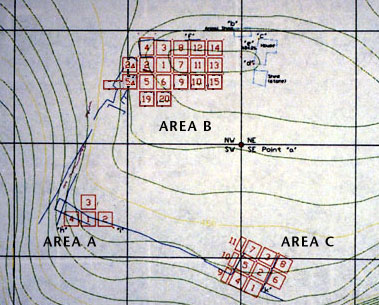 To begin work, a surveyor plots a topographical or topo map of the site and a grid of squares is laid out across the mound. The topo provides the archaeologist with the elevation and contours of the mound. The grid plan is a system of 5 x 5 meter squares with a 1 meter standing section or balk in between. With this grid we can precisely locate the position of every wall and object three dimensionally (length, width, depth) and transfer that information to a plan or map.
To begin work, a surveyor plots a topographical or topo map of the site and a grid of squares is laid out across the mound. The topo provides the archaeologist with the elevation and contours of the mound. The grid plan is a system of 5 x 5 meter squares with a 1 meter standing section or balk in between. With this grid we can precisely locate the position of every wall and object three dimensionally (length, width, depth) and transfer that information to a plan or map. 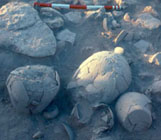
For example, because of our grid, we know that the large vessel pictured here was found in Square B8 and it was precisely located 2.5 meters from the north balk and 1.5 meters from the east balk.
Actual excavation does not begin until there is a random survey of the site. At Khirbat Iskandar we sherded the squares, but also picked up any objects or any evidence of material culture. After completing the survey, we spent a few weeks excavating two probes in order to glimpse the stratigraphy of the mound. The goal of a pilot season, like ours in 1981, is to gather sufficient information to decide whether or not long-term excavations will resolve your questions. Khirbat Iskandar met that test: there were extensive stratified remains of EB IV occupation on the mound.
For the actual dig, excavators can choose their squares by a random method, or they can use the results of the survey plus a consideration of the architectural remains visible on the site. We chose the latter method and opened three major fields, which we continue to work in: Area A at the southwest, Area B at the northwest, and Area C at the southeast. 
Excavation
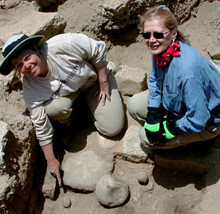 When digging begins, a student is assigned to one square and gradually excavates downward, layer by layer. This is vertical excavation, which provides chronology and a stratigraphic profile of the site. Other students in many adjoining squares are doing the same thing. This provides a wide exposure of each layer or phase and is called horizontal excavation; that is, the layer across all the squares dates to the same time, or is contemporary. A wide exposure like this allows archaeologists to make theoretical inferences about society, economic conditions, political structure, and everyday life.
When digging begins, a student is assigned to one square and gradually excavates downward, layer by layer. This is vertical excavation, which provides chronology and a stratigraphic profile of the site. Other students in many adjoining squares are doing the same thing. This provides a wide exposure of each layer or phase and is called horizontal excavation; that is, the layer across all the squares dates to the same time, or is contemporary. A wide exposure like this allows archaeologists to make theoretical inferences about society, economic conditions, political structure, and everyday life.
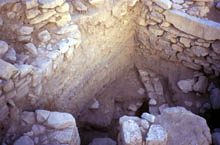 This photo from Square B2, however, shows the chronology or history of the site through 5 phases: Phase A wall at the top overlies a Phase B wall, which in turn overlies a mudbrick and stone Phase C wall, under which is a Phase D wall and further below, a Phase E wall.
This photo from Square B2, however, shows the chronology or history of the site through 5 phases: Phase A wall at the top overlies a Phase B wall, which in turn overlies a mudbrick and stone Phase C wall, under which is a Phase D wall and further below, a Phase E wall.
Tools
Many kinds of tools are used on a dig. Sometimes hoes and large picks and shovels are used. Usually though excavation proceeds very slowly and methodically with a small pick, a trowel, a dustpan, a brush. If the object is very delicate, dental tools, paint brushes, and syringes for blowing away dust, are used. 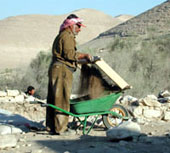 Dirt is deposited in a rubber basket, or Gufa and carried to a wheelbarrow. At the wheelbarrow, the soil is either sieved or it is taken to the "dump." An excavator also needs other equipment like string, a line level, a plumb bob, and metric tape measure in order to measure and record the exact location of an object. And in many ways, the most important piece of equipment is the notebook. Without the documentation, all the work in the field is lost.
Dirt is deposited in a rubber basket, or Gufa and carried to a wheelbarrow. At the wheelbarrow, the soil is either sieved or it is taken to the "dump." An excavator also needs other equipment like string, a line level, a plumb bob, and metric tape measure in order to measure and record the exact location of an object. And in many ways, the most important piece of equipment is the notebook. Without the documentation, all the work in the field is lost.
Post-Excavation Research
Most archaeologists would say that the real work begins after the dig. Although you spend six weeks or more digging, it often takes years to research, analyze, interpret and finally, publish the results. Essentially, specialists and students organize and catalogue everything in the lab. This is what we are doing in the Gannon Institute for Archaeological Research.
The bones, soil samples, lithics, radiocarbon (C14) samples, seeds, objects and other materials are sent off to specialists. Usually the ceramics and the architectural drawings and notebooks are studied by the directors and field supervisors. The archaeologist must study all the pottery by phase and set up a classification system or typology. In this way, the development of types of pottery through time can be charted.
Pottery in many ways is the most important artifact since it can be used for dating purposes. Once the date is known, then a comparison can be made with similar pottery from other contemporary sites. For example, the EB IV pottery on display at the Museum links Khirbat Iskandar to hundreds of other sites between the dates of 2300-2000 BCE.
The goal of the archaeologist is not to concentrate only on one site, but to attempt to illuminate the entire culture of the people living at that time. The publication of a site adds immensely to the knowledge of ancient cultures and allows others to use and build upon those results.